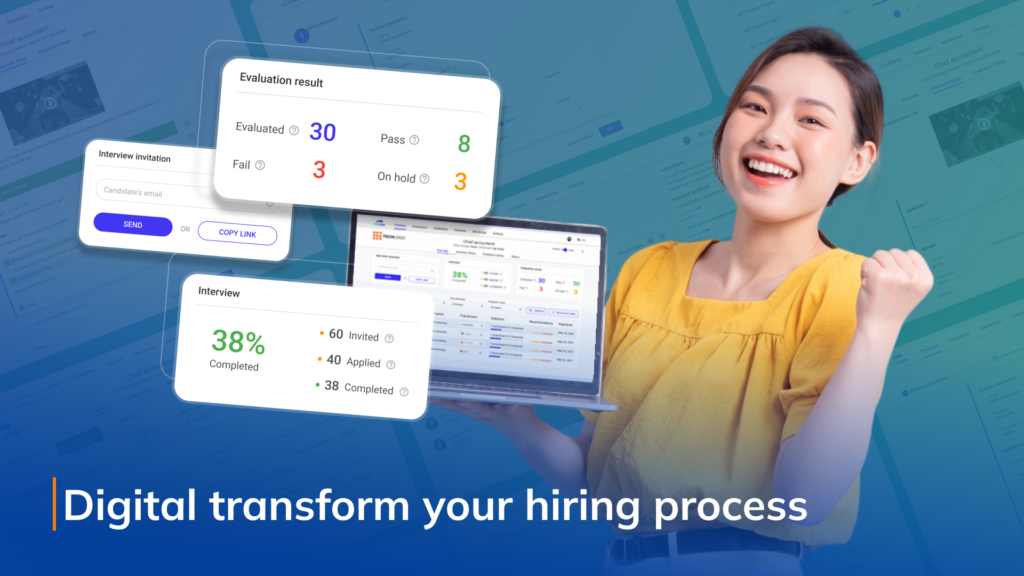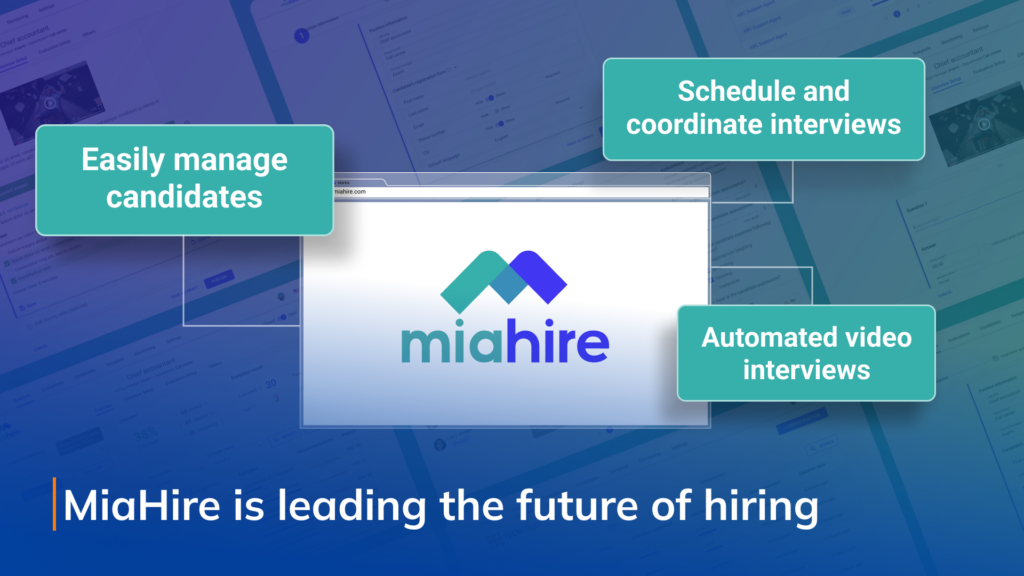Simplify high volume hiring with MiaHire: The Future of Video Interviews
19/06/2023
1.58k
Say goodbye to the hassle of coordinating interviews with multiple candidates and team members. MiaHire offers an on-demand video interview platform that allows you to conduct interviews at your convenience. With just a few clicks, you can invite candidates to complete recorded video interviews that fit their schedule, eliminating the need for tedious back-and-forth communication.

Challenges in the HR Market: The Issues with Traditional Recruitment
The HR market faces numerous challenges with traditional recruitment processes. The outdated recruitment process consumes substantial manpower and incurs operating costs. In addition, the conventional approach, involving resume screening followed by in-person interviews, often leads to inefficiencies and missed opportunities. Resume screening can be time-consuming and subjective, making it difficult to assess candidates accurately. Additionally, scheduling in-person interviews poses challenges, especially when dealing with a large number of applicants or coordinating with multiple stakeholders. Geographical constraints further limit access to potential candidates, hindering organizations’ ability to attract diverse talent.
Moreover, relying solely on resumes limits the evaluation of crucial candidate attributes, such as communication skills and cultural fit. Resumes alone cannot comprehensively understand a candidate’s capabilities, personality, or potential for growth within the organization. This limitation can result in missed opportunities to identify qualified candidates with the desired skills and traits.
MiaHire: Your Effective Video Interview Solution for Large-Scale Recruitment
MiaHire revolutionizes the hiring process by offering a range of key features that address various recruitment needs. For specialists, the platform replaces traditional resume screening and in-person interviews with video interviews, enabling organizations to efficiently handle a large volume of applications without missing out on top candidates. In customer service roles, MiaHire allows employers to assess candidates’ communication skills, which are often difficult to gauge from resumes, and do so at scale. Manual worker positions benefit from MiaHire as it serves as the sole screening method when evaluation criteria are clearly defined.
On-demand video interview: Candidates can join anywhere, anytime
For organizations seeking to recruit foreign talents, MiaHire proves highly effective in testing language abilities, enabling employers to focus their efforts on qualified candidates for further evaluation. Furthermore, MiaHire represents the future of job interviews by offering an end-to-end replacement for the first round of interviews. With no need for interview scheduling, candidates can choose the time and place that suits them best, while employers can conveniently review interviews right away, all within the platform.
Fast and easy management: Get rid of time-consuming traditional management
MiaHire brings extreme efficiency to the hiring process, relieving overwhelmed hiring teams from resume screening, shortlisting candidates, and scheduling interviews. The platform simplifies the process by allowing hiring teams to send applicants a MiaHire interview URL and receive notifications once the video interview is completed. This eliminates the cumbersome process of contacting candidates multiple times and scheduling interviews with interviewers.
With MiaHire, there are no more mismatches, only great candidates. Moreover, interviewers only need to set up the questions once, eliminating the need to repeat the same questions to each candidate. Additionally, MiaHire mitigates the risk of candidates not living up to their résumés, saving valuable time by swiftly moving on to the next candidate if necessary. By leveraging video interviews, employers can identify candidates’ true potential beyond what their résumés may show.

Below are some highlight features of the video interview platform you are looking for
- Automated Video Interviews: Conduct video interviews easily and efficiently
- Candidate Management: Easily manage candidate profiles and applications.
- Interview Scheduling: Schedule and coordinate interviews hassle-free.
- Data Security: Ensure data privacy and security with robust encryption measures.
- Advanced Evaluation Tools: Evaluate candidates effectively with customizable assessment criteria.
- Centralized Platform: Track multiple positions and manage interview results in one place.
- Customization Options: Tailor interview content to align with job requirements and company values.
- Collaboration Capabilities: Enable smooth collaboration among hiring managers, interviewers, and team members.
- Time and Cost Efficiency: Streamline the hiring process, saving time and reducing operational costs.
These features make MiaHire a comprehensive and efficient solution for all your recruitment needs.
The Development Journey: Creating an Innovative Video Interview Solution for high volume hiring
The development of MiaHire involved a meticulous and well-executed process that focused on understanding market needs and trends. Extensive research and development (R&D) provided the foundation for the platform, enabling the team to identify key challenges faced by HR teams and job seekers alike. Secondly, brainstorming sessions allowed a diverse team of experts to generate innovative ideas and define the product’s features and functionalities.
Then, prototyping and testing played a crucial role in refining MiaHire’s user interface and incorporating valuable user feedback. Throughout the development process, the team encountered challenges, particularly in navigating the competitive HR market and integrating cutting-edge technologies. However, these challenges were met with strategic approaches. MiaHire invested in building a strong brand identity and value proposition to differentiate itself in the market. Last but not least, collaboration with experienced developers and continuous research and development helped overcome technological challenges, ensuring compatibility, scalability, and security.
Development systems and technologies
Below are the resources and technologies we use to develop Miahire services:
Details of entrustment: Design, Implementation, Testing, Migration, Maintenance & Operation
Platform: Web app, responsive web app
Infrastructure & Architect: GCP, Serverless, NoSQL
Development language: NodeJS, React, Typescript
Transforming Hiring Performance
The outcomes and impact achieved with MiaHire have been significant, both for the product itself and its clients. Since its launch, MiaHire has facilitated high-volume hiring and over 10,000 interviews between candidates, showcasing its wide adoption and effectiveness in the market. One of its key achievements is the platform’s ability to empower clients to recruit instantly.

Empowering Candidates: The Benefits of Recorded Video Interviews
Candidates benefit from participating in recorded video interviews by enjoying flexibility in terms of time and location, enhanced convenience, reduced pressure, the ability to review and improve their performance, increased confidence, equal opportunities, and the opportunity to provide thoughtful and well-prepared responses. These advantages ultimately allow candidates to present themselves in the best light and increase their chances of securing their desired job opportunities.
Transforming the way employers hire
MiaHire’s review and evaluation features have also transformed the efficiency of the hiring process. Hiring teams can assess candidates’ responses efficiently, regardless of their location. This saves valuable time and allows for informed and collaborative decision-making. Employers can review interviews at their convenience, involve multiple stakeholders in the evaluation, and make data-driven hiring decisions.
Moreover, MiaHire has played a pivotal role in ensuring equality in the hiring process. The platform utilizes video interviews to mitigate biases associated with traditional face-to-face interviews, focusing solely on candidates’ qualifications and responses. This creates a fair and objective assessment environment, promoting diversity and inclusion within the hiring process.
A Future of Efficient and Fair Hiring
MiaHire’s innovative platform has ushered in a new era of efficient hiring processes. With its user-friendly interface, flexibility in interview scheduling, and robust evaluation features, MiaHire aims to transform recruitment efficiencies for organizations worldwide.
As the industry evolves, MiaHire remains committed to innovation. Therefore, the upcoming integration of AI-driven features will further streamline the evaluation process, reduce manual effort, and provide data-driven insights for employers. These advancements will revolutionize how companies identify and select top talent, ensuring greater efficiency, fairness, and effectiveness in high-volume hiring.
In conclusion, organizations in a competitive job market should embrace cutting-edge solutions to stay ahead of the curve. The future of hiring is here, and MiaHire is leading the way.
Discover the cutting-edge breakthrough products from SupremeTech.






















